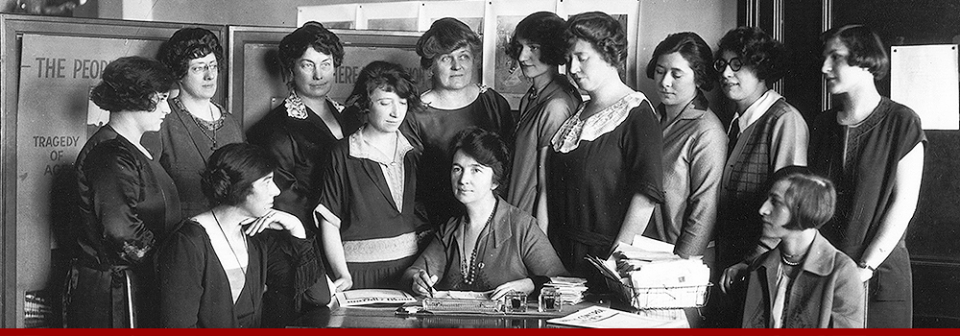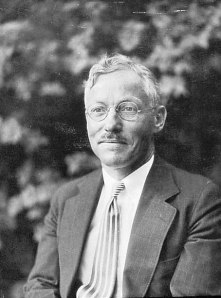My interest in the Margaret Sanger project began after writing a paper for my History of Biotechnology class. I decided to write my unit paper on how the advent of the birth control pill led to the challenge of who was in control of reproduction.
Where would I look?
This is where that Google search box in the upper right-hand corner of my computer came in handy. I searched ‘Margaret Sanger’ and the first site to come up was the Margaret Sanger Papers Project.
This initial inspiration led me to conduct research on the birth control movement in England. While doing research at the British Library and the Wellcome Library, I came across several pamphlets and books written by a Helena Rosa Wright. As my previous exposure to the history of birth control had mainly focused on the movement in the US, I didn’t recognize the importance of this name. Eventually, my research would revolve around the ideals of Wright.
Now as I sit here working at the Margaret Sanger Papers project I wonder, did these two women ever meet?
Fortunately, the collections at the Project responded to my question: yes, they did meet and on several occasions.
I wanted to know more, so I asked a more difficult question: How did these two birth control advocates interact?
This question would be much more difficult to answer. I’ve spent the majority of my day looking over reports from IPPF conferences that they both attended, research reports done by colleagues and the correspondence between the two women in order to lace together their relationship.
Firstly though, I believe some background information on Wright is necessary.
In 1915, Helena Rosa Wright (née Lowenfeld) graduated as a doctor from the London Royal Free Hospital School of Medicine for Women. Not long afterwards, she began her training in gynecology. During the 1920’s Wright spent time as a missionary associate professor of gynecology in China with her husband, Peter Wright. After returning to London, she worked at the Women’s Welfare Center in Telford Road where she encouraged the center to focus on contraceptive services and education. She began to speak at conferences concerning the effects of sex and contraceptive education. Eventually, those who were voluntarily partaking in promoting sex and contraceptive education, along with Wright, formed the National Birth Control Association. Wright was one of the individuals responsible for the formation of the International Committee on Planned Parenthood (would become the International Planned Parenthood Federation). In 1951, Wright would be elected as treasurer of the IPPF.
Alright, there are some basic details. Now to get into what might be some drama.
Wright first met Sanger at a conference on International Birth Control in Zurich. From the research that I have examined, Wright admired Sanger and her work.[1] Sanger, in a letter to Clinton Chance, praises Wright’s work on sex and contraceptive education.[2]
Okay, that seems like a good start. This also seems like a good place to discuss what the two activists had in common.
The simplest way to look at it is that both women wanted access for women to contraceptives. Both women understood that the access to contraceptives would improve women’s health.

Helena Wright lecturing to midwives in Warsaw & using her model of the female sex organs, 1957 (photographer unknown).
Furthermore, both Wright and Sanger advocated for greater understanding of sexual expression. Sanger would publish Woman and the New Race and Wright would publish Sex and Society. In both publications, the women discussed the necessity of individuals to understand and develop their sexual expression separate of its role in parenthood. Wright and Sanger also discuss how the conception of sex must be recreated. In both works, the dissociation of sex from pregnancy will lead to a new “social code” according to Wright or a new “sex morality” as stated by Sanger. [3][4]
Both advocates used similar terminology to describe the present conception of sex. Sanger described that society associated sex with being unclean and Wright explained that sexual pleasure had, for too long, been connected with guilt and was a dirty act to be practiced.[5][6]
So what would fundamentally change about the current conception of with the development of the new “social code/sex morality”?
Basically, sex would be separated from reproduction. Sanger described this as giving women the opportunity to “know themselves” and to “develop her love nature separate from and independent of her maternal nature.”[7]
For Wright and Sanger, the access to and knowledge of birth control were necessary to make these social changes. In Woman and the New Race (1920), Sanger acknowledged this access to knowledge:
To achieve this [new sex morality] she must have a knowledge of birth control.
One would think that Sanger and Wright would get on well. But they didn’t. They ended up on different sides of some of the early ideological battles within the IPPF over its mission and makeup.
According to the biography, Freedom to Choose: The Life and Work of Dr. Helena Wright, Pioneer of Contraception, Evan’s describes Wright as an advocate of sex education. who was “less interested in controlling populations than in liberating women.”[8]
Using this statement, we can more clearly juxtapose Wright and Sanger.

Wright with Professor Karl-Heinz Mehlan (Right) and Professor Hans Harmsen (behind), at the twenty-first anniversary Conference of the International Planned Parenthood Federation, Brighton 1973 (Pic Photos).
The IPPF was a collaboration between birth control groups that had very different ideas about what needed doing. Most of the British contingent focused on opening birth control clinics, while many Americans were driven more towards arguments about overpopulation and were interested in contraceptive research. The Dutch and the Scandinavians saw birth control as one part of a larger sex education movement. With limited resources, the IPPF had to decide what to do first. Intent on getting a functioning IPPF started, Sanger had little patience for the broader sex education and sex reform ideas of members like Wright and the Scandinavians.
The IPPF Medical Handbook had earlier described the uncontrolled population growth as the problem confronting the world “by the teeming millions of uneducated people to whom the conventional methods of contraception are beyond contraception.”
Here we can see that others like Margaret Sanger who held Neo-Malthusian views, believed contraceptive education and access to birth control were necessary to control population growth.
On the other hand, there were those, like Wright, who felt that population control was “one of the most dangerous and self-defeating ways of expressing our aims and intentions. Diminution of population numbers might be a result, not an aim.”
During the 1950s, the IPPF was struggling to gain government support. The IPPF had applied for membership as a consultative organization in the United Nations Economic and Social Council for work on population control and family planning. The opportunity, which did not succeed, pushed the IPPF’s sex reform goals to the side.
Sanger’s emphasis on population control versus Wright’s emphasis on sex education reform may have been to gain greater financial support from governments and foundations like the Rockefellers since their interest in birth control was mainly for goals of population control.
There also seemed to be personal issues between Sanger and Wright. In the same letter addressed to Clinton Chance, Sanger writes: “her [Wright] judgment is a little dipsy and not at all to be relied upon, as far as personalities are concerned.”[9]
Sanger goes on to criticize Wright’s position as treasurer of the IPPF, stating that her election was not based on her ability with finances but because there had previously been a dishonest person employed in the position. Sanger continued to explain that “we must have a person of more experience.”[10]
To further stress their relationship, Wright took issue with the Clarence Gamble. In the 1950’s, Gamble attempted to persuade western birth control workers to use cheaper contraceptives. At the 1952 3ICPP conference in Bombay, Wright challenged Gamble, explaining that this method was unacceptable as it injured the user. This, however, did not stop Gamble from continuing his work. [11]
In terms of the Wright-Sanger relationship, Sanger, who had for years received financial support from Gamble, defended his distribution of cheap methods of birth control.
Through all this, it seems that Wright and Sanger maintained a professional relationship. The correspondence between the two advocates remains cordial as it mostly pertains to business regarding the IPPF.
Hmmm…I may just be meddling.
[1] Evans, B. Freedom to Choose: The Life and Work of Dr. Helena Wright, Pioneer of Contraception, London: Bodley Head, 1984, 208.
[2] MS to Clinton Chance, Jan, 9, 1953 [MSM S40:650].
[3] Sanger, Margaret. Woman and the New Race. New York: Brentano’s, 1920.
[4] Wright, Helena. Sex and Society. London: George Allen and Unwin Ltd., 1968, 72.
[5] Ibid.
[6] Ibid., 90.
[7] Sanger, Margaret. Woman and the New Race. New York: Brentano’s, 1920.
[8] Evans, B. Freedom to Choose: The Life and Work of Dr. Helena Wright, Pioneer of Contraception, London: Bodley Head, 1984, 242.
[9] MS to Clinton Chance, Jan, 9, 1953 [MSM S40:650].
[10] Ibid.
[11] Linder, Doris H. Crusader for Sex Education: Elise Ottesen-Jensen (1886-1973) in Scandinavia and on the International Scene. London: University Press of America, 1996, 186.


